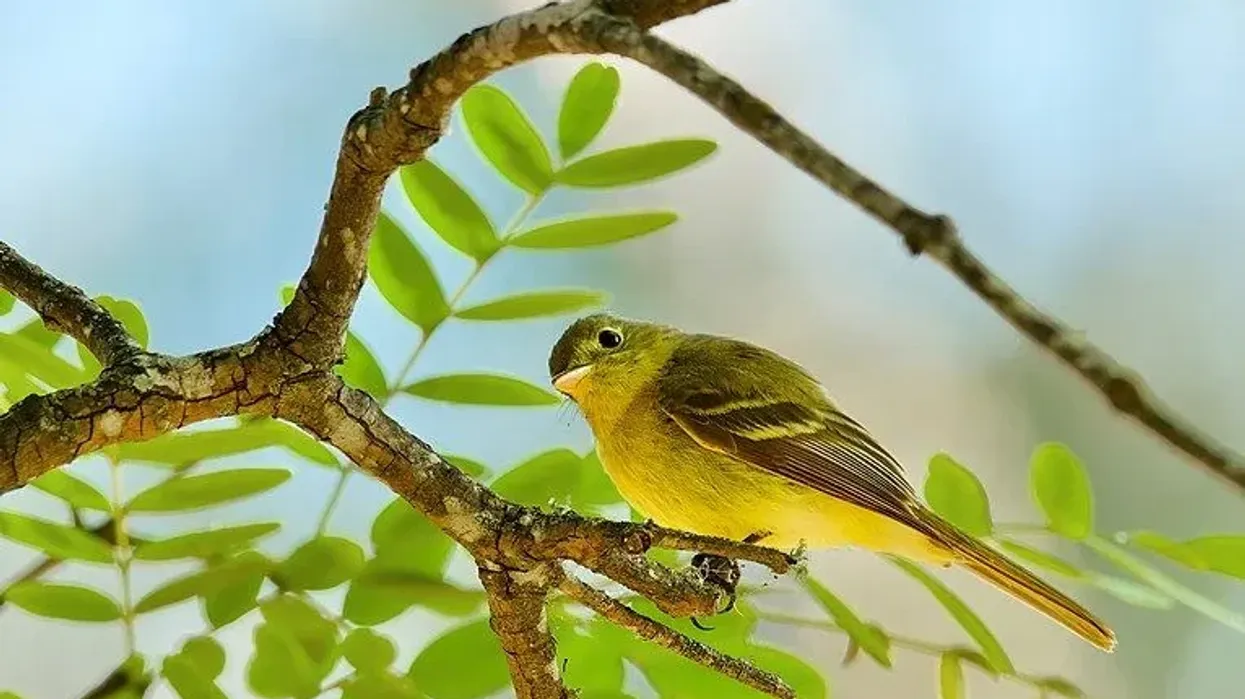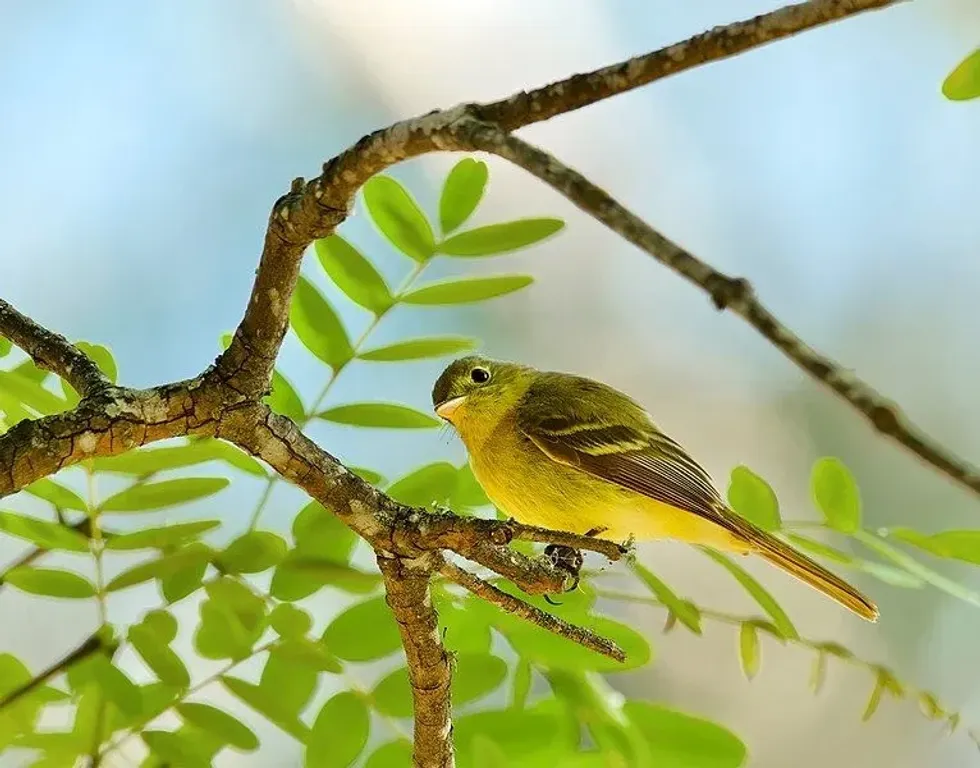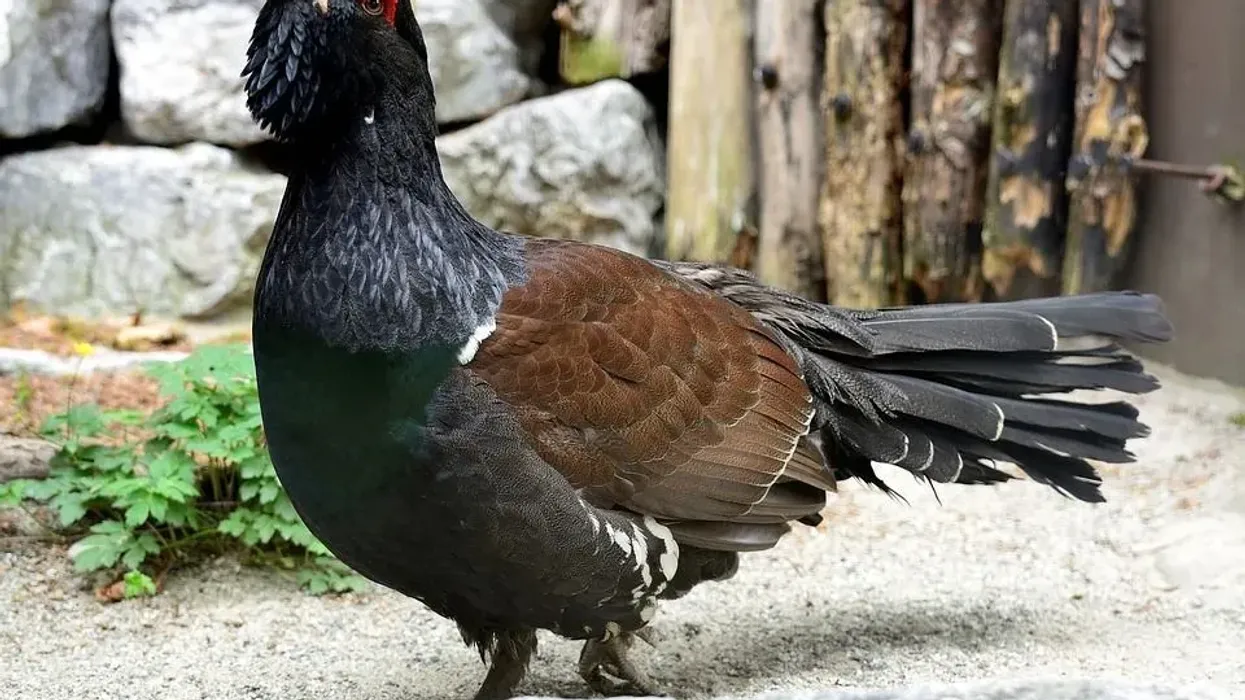The Pacific-slope flycatcher (Empidonax difficilis), one of the two species of the western flycatcher along with the other species of Cordilleran flycatcher, lives in the countries of North America. The fact that it is difficult to distinguish the two species is due to their physical similarities.
Pacific-slope flycatcher identification relies on its vocalizations that are slightly different from the other western species, the Cordilleran flycatcher of the order Passeriformes, family Tyrannidae.
Empidonax flycatchers live in the wild habitats of mixed woods including deciduous, coniferous woodlands in southern California, Mexico, Arizona, the Channel Islands, and along the Pacific coast in North America. The harsh cold winter months are spent by these birds in coastal lowlands and the southern part of Mexico.
The species is mostly insectivorous and are found to wait patiently on a tree perch to catch their prey. They mainly eat spiders, moths, bees, bugs, beetles, and wasps.
This bird species has yellowish olive underparts and brownish strokes on the upper part of the wings. They have a broader bill and a large head along with a long tail and grey legs. Their broader bill helps them to catch their prey.
For more relatable content, check out these swallow facts and palm cockatoo facts for kids.
Pacific-Slope Flycatcher Interesting Facts
What type of animal is a Pacific-slope flycatcher?
Pacific-slope flycatchers are sweet, little migratory birds with fluffy feathers and a cute crown. It is a type of flycatcher.
What class of animal does a Pacific-slope flycatcher belong to?
Pacific-slope flycatchers belong to the class of Aves. This species of bird, belonging to the order Passeriformes, family Tyrannidae, is known to have the scientific name Empidonax difficilis.
How many Pacific-slope flycatchers are there in the world?
The latest evaluation made by the Avian Conservation Assessment Database shows that there are about 9.5 million Pacific-slope flycatchers in the world.
Where does a Pacific-slope flycatcher live?
This species of western flycatcher lives in a wide range of forests. This species practices migration for surviving in nature and is found living in mixed forests.
Their forest habitats include a range of deciduous forest and coniferous forest. These yellow birds also make their nest in littoral forest regions near gorges. During the winter season, they descend to the foothills, the forests amidst mountains, and low lands along the sea coast.
What is a Pacific-slope flycatcher's habitat?
The habitat of this species (Empidonax flycatchers) is centered around North America. The range of habitats of this bird species includes deciduous and coniferous woodlands in southern California, Mexico, and the Channel Islands for breeding purposes.
They prefer humid forests and shady nests, so they make their nest on trees near brooks or gorges. These birds perform migration during the winter season and often descend to warmer forests near the foot of mountains and the southern part of the continent in lowlands and along the Pacific coastline.
Who do Pacific-slope flycatchers live with?
This species of western flycatcher comprises birds who prefer to spend their time unaccompanied except during the breeding season and migratory flights. During other times, they are often found to sit on an advantageous perch and wait patiently to catch insects.
How long does a Pacific-slope flycatcher live?
This species of North American birds survive for about six years in the wild. The least flycatcher has a similar lifespan.
How do they reproduce?
These yellow birds of North America can be both monogamous and polygynous. The female and male birds become prepared for breeding at one year of age.
The female usually makes the nest on a tree 15-20 ft (4.6-6.1 m) above the ground during the breeding season. It is the female bird that incubates the eggs.
The breeding season ranges from April to July. Male birds communicate through vocalizations and sing songs to attract breeding partners, and the females lay about three to four eggs that are white in color and are slightly marked with brown patches.
The incubation phase lasts about 14 days, with the hatched young birds learning to fly at an early age. The adult birds protect their nests and bring food for their young ones.
What is their conservation status?
The conservation status of this North American bird species does not attract enough concern due to their abundance. Although many reports suggest that their population is on the decreasing slope of the population graph, this population decline has not stirred any serious concern for the conservation of this species.
They are listed as under the category of a Least Concern species as stated by the IUCN Red List.
Pacific-Slope Flycatcher Fun Facts
What do Pacific-slope flycatchers look like?
The Pacific-slope flycatcher (Empidonax difficilis) is very difficult to distinguish from a similar species, the Cordilleran flycatcher. The species of Pacific-slope flycatchers are small, fluffy birds with a relatively larger head and a dew drop-shaped eye ring which is a distinct feature of their physical description.
You can identify and differentiate Pacific-slope flycatchers from other flycatchers through their physical appearances. The Empidonax flycatcher bird has a light yellow or olive lower mandible and a broad bill that helps them to catch insects as they sit or perch on a tree.
Although the lower mandible is lighter in shade, the bird species have brown feathers that enhance their color range. They also have a long tail but smaller wings.
The primary identification between the two western species of the same family, the Cordilleran flycatcher and the Empidonax flycatcher, depends on their vocalizations as the Pacific-slope flycatcher call and distance range differs from those of Cordilleran flycatchers.

How cute are they?
These little birds, both the species of Empidonax and Cordilleran, look fluffy like a cotton ball with a color range of pale yellow, olive, and brown. The crown of feathers above their head looks similar to a haircut.
This, along with the dewdrop-shaped eye-ring, makes them a perfectly cute treat to the eyes as well as to the ears for their sweet song.
How do they communicate?
The Pacific-slope flycatcher song range is distinct and differentiates from that of Cordilleran flycatchers. The birds in this species have a song range, including sweet calls like 'peewee' and short 'tseep', which they use to communicate among themselves.
How big is a Pacific-slope flycatcher?
Pacific-slope flycatchers are slightly larger in size than European pied flycatchers. Flycatchers of this species measure about 5.5-6.7 in (14-17cm) in length. Comparing sizes, the species of Pacific-slope flycatchers range larger than a tailorbird and comparatively smaller than a robin.
How fast can a Pacific-slope flycatcher fly?
Pacific-slope flycatchers are migratory birds and fly long distances during migration. However, any distinct measure of the speed of their flight is not known.
How much does a Pacific-slope flycatcher weigh?
Pacific-slope flycatchers have a weight range that is 0.016-0.026 lb (8-12 g).
What are the male and female names of the species?
There is no specific name that has been assigned to the male and female individuals of this species.
What would you call a baby Pacific-slope flycatcher?
The young ones of Pacific-slope flycatchers have no specific name. However, like with other birds, a baby flycatcher can be called a chick or a hatchling.
What do they eat?
The diet of this bird species mainly includes insects like bugs, beetles, wasps, worms, flies, mosquitoes, spiders, moths, and bees. Berries are also a part of their diet.
Are they poisonous?
These sweet, little birds make their nests in their wild habitats and live in solitary, catching insects on a perch. They only travel for migration purposes and are not known to be poisonous or harmful to humans.
Would they make a good pet?
These birds look like cute cotton balls and may impress anyone who might want to pet one of these birds. However, these birds require to live in the woods so that these birds do not miss out on their natural habitat and a good supply of insect snacks. They cannot be tamed as a pet.
Did you know...
The color ranges of these birds help them to camouflage themselves in woodlands except in the season of migration and during the breeding seasons in April.
Pacific-slope flycatchers play a very important role in maintaining the balance of the natural ecosystem as the population of insects is regulated by this bird species.
This bird species is often parasitized by cowbirds who lay eggs in their nests, making them feed and look after the young one of a cowbird which is even larger in size compared to an adult Pacific-slope flycatcher.
What is special about the Pacific-slope flycatcher?
Pacific-slope flycatchers belong to the family Tyrannidae. The word 'Tyrannidae' came from the Latin word 'Tyrannus', which means a 'tyrant'. The birds of this species were classified under this family due to their nature of defending their nest from relatively larger birds like crows.
Do Pacific-slope flycatchers migrate?
Pacific-slope flycatchers practice long to medium-distance migrations and fly towards coastal lowlands during harsh cold months. These birds migrate between the colder months and the breeding sessions.
Here at Kidadl, we have carefully created lots of interesting family-friendly animal facts for everyone to discover! Learn more about some other birds from our umbrellabird facts and bee-eater facts pages.
You can even occupy yourself at home by coloring in one of our free printable Pacific-slope flycatcher coloring pages.









